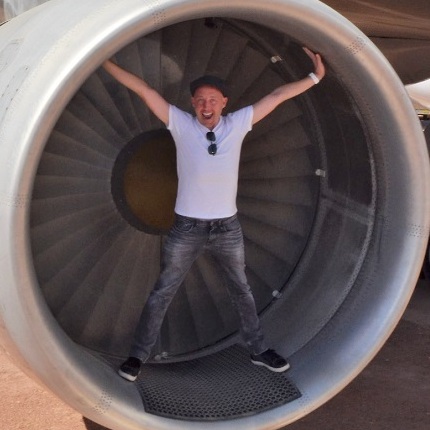viewtopic.php?f=3&t=1419061
For those of you who are just joining, you may want to begin with the first four articles, which can be found here:
viewtopic.php?f=3&t=1419683
viewtopic.php?f=3&t=1420157
viewtopic.php?f=3&t=1420685
viewtopic.php?f=3&t=1421125
Intro: Following the Sheepskin Trend While Reorganizing Cabins
After hundreds of hours of research and writing, I finally commence the final, fifth article about the final era of Pan Am’s 747 cabin design. This was truly the end of the road for the struggling airline, but they never gave up along the way. By this point, the 747s had received the updated billboard paint scheme that had evolved from the low stripe experimental paint scheme from a few years earlier. Immediately following, announced in late 1986 for an arrival in early 1987, was to be a complete makeover of the 747 cabins to go along with the newly painted planes. The challenge was how Pan Am aircraft interiors would relate directly to the company’s new livery. Both the 747-100 and 747-200 would receive the new cabins, and they would be laid out differently based on the airline’s identified needs. In came the Pan Am Blue Program, a program designed to overhaul all three of the cabins across the fleet. Now that the interior was going to get an update again, Pan Am would capitalize on the two types of 747s being different, and would lay them out different accordingly.
Pan Am had identified that the South American market yielded some of the highest revenue paying passengers, who were more willing to pay for first over clipper class. While there were a few 747-100s which were in this configuration, it was primarily the 747-200, so I am going to refer to the South American configuration as the 747-200 configuration throughout this piece. In this South American configuration, the B-Zone became first class, with an increase of eighteen first class seats as compared to the primary configuration. Also, the clipper class was pushed back further into the cabin- increasing the number of clipper class seats by eight as compared to the standard 747-100. The standard 747-100 had gained seating, and its capacity increased from 381 to 412 compared to the previous era. In an interesting turn of events, Pan Am had now outfitted the 747-200s (South American) seating with fewer than the 747-100s, at 377 seats. The reasoning was because the entire B-Zone of the 747-200, which was previously clipper class, had now been converted to first class, resulting in fewer overall seats. Originally, in 1987, the 747-200 of this era was 347 seats, then they added four clipper seats, twenty seven coach seats, and subtracted one first class seat in 1989, bringing it up thirty seats to 377 total (added seats are highlighted yellow on seat charts throughout article). In a class by class comparison, the final 747-100 offered 21/44/347, whereas the final 747-200 offered 39/52/286.

Now that we have discussed the reorganization of cabins for the final era, let’s talk about the trends and people associated with this era in design for Pan Am. The biggest cabin trend of the late 1980s was that of lambswool. All around the industry, this now controversial, then vogue covering, would create some of the softest journeys in passenger transport. Today’s seats, industrious and ever-adjusting, certainly have their advantages, but lack the cushy sink-in-your-seat feeling that lambswool offered. One airline which heavily promoted the use of lambswool seating at the time was American Airlines. In the mid to late 1980s, wide-body American flagship international planes including the DC10, 767, and 747SP, were outfitted with new cabins featuring sheepskin and leather sleeper seats. Weber would be the primary designer and manufacturer of airplane seats for American for years to come, and Pan Am saw this trend loud and clear.
To remain competitive, and take one last stab at the market, Pan Am hired Jennifer Coutts Clay, to spear-head the Pan Am Blue Program, and re-do all three of their cabin offerings. Through the design direction of Philip and Gail George, Jennifer laid out a comprehensive overhaul of the 747-100 and 747-200 cabins (in addition to the intro of the new Airbus A310-300 cabins at the time) within no doubt a tight budget- The budget was $25,000,000 to re-do all the cabins. Through the systematic approach of simplifying the cabins and focusing on the materials, Clay would transform the cabins into the final era design that would last from 1987 until Pan Am’s demise on December 4, 1991.
1987-1991: Three Final Cabins for a dying Airline
This is it. This is what it all came down to. The final cabin designs. Beginning with the first class cabin, we had discussed it was located in the A-Zone in the 747-100, and in the A and B-Zones in the 747-200. There was increased capacity in the 747-200 as they had identified the South American routes as yielding more first class passengers and therefore greater revenue potential. As stated earlier, in 1989, the 747-200 lost one first class seat in its configuration as well. The seat designs were new for the first time since 1979. While they retained the sleeperette function, the design was now Lackawanna genuine leather dyed navy blue with a matching one piece Australian merino sheepskin covering the center insert. This was very popular in the industry, and weber, the company who provided American with nearly all its seats, would also be the manufacturer of this seat exclusive to Pan Am. The sheepskin insert changed from inception to conclusion. The initial sheepskin was a dark blue, almost black look. The final sheepskin was a lighter grey and was inserted in the same place. The initial seats were an experiment using strands of sheepskin that could be brushed clean, but the seats molted and went bald very quickly. They changed it to a more resilient lighter gray product that worked with a special light-suction vacuum designed just for cleaning the sheepskin. The seat pitch was 55 inches, the recline was 60 degrees, and the width was 26.5 inches. Also to note: They changed the leg rest from a two-piece system, to a one-piece system in 1990. When they did this (on the 747 and A310), the life vest moved from under the seat, to between the seats per a company memo. In the single seat (1J), the life vest moved to the wall, and the flight attendant was briefed to show the passenger in that seat the change. There was no longer a headrest cover of any kind- most likely to cut down on cost and the switch-out time. Gone were the graceful days of meticulousness, and in came the bureaucratic days of getting it done on a dime. The credenza in the center of first class got a gleaming silver finish on the side panels, and the top surfaces were surrounded by navy blue leather. An interesting point is that the 747-100 first class featured twenty-one seats at this time, and that was the fewest amount of first class seats in the section to date. The only other major change to the first class cabin was that a big silver globe portrait now adorned the nose-cone wall. That wall was an evolution of the clipper ship designs promoting exploration and Pan Am’s experience. The first class cabin was not the only star of the make-over show however. Clipper class would also get a rejuvenation.

Moving down the cabin, revealed the new clipper class. The location of the clipper class was the B-Zone and upper deck of the 747-100, and the front of the C-Zone and upper deck of the 747-200. On the 747-200, four extra seats were added in 1989 to the main level. The seat design was a new all-in-one design. While clipper class remained the same six abreast layout, the seating had been significantly updated to a more demure herringbone-weave tweed purchased from Aabe. Philip George, the designer, stated that he got the inspiration from the sight of surface-stitched leather elbow patches, and the traditional tweed jackets worn by members of the English gentry during the hunting season. This would be the first time pan am deviated away from cloth fabrics along with the new first class lambswool and leather cabin. The seats featured stitched in leather headrests covers and seat back pockets. They were initially upholstered in brown, or gray tweed with a dark brown sewn-in leather headrest. Later in the cycle, all of the seats had changed to gray with a dark blue leather headrest sewn in due to maintenance implications. These later seats used the remnants left over from the first class leather seating material to keep costs down. Seat pitch was 38 inches, the recline was 33 degrees, and the width was 26.5 inches (same width as first class). In the mid-1980s, Pan Am had stated that they were going to add leg support to their clipper class seats as TWA and others at the time had evolved one step further from the six abreast setup to include those as well. Unfortunately, Pan Am would never get around to implementing this due to budget constraints. That was the fist time I saw them not go through with a cabin update they had planned, in all of my research. Since clipper class was also upstairs during this era, let’s go upstairs next.

While they did not get the leg rests installed as planned, the upper deck still remained clipper class as it had previously been. It received the same update to the seats as the main floor. The upper deck of the 747-200 housed two additional clipper class seats thanks to its more open layout. There was not much that changed otherwise. I did find it interesting that they kept the upper deck as clipper class on the 747-200 when the entire A and B zones were first class. It felt like an after thought that the upper deck did not become first class as well given the area of the cabin and the methodology. Finally, we go downstairs and to the back of the plane. To the final cabin of the final era of Pan Am’s 747 cabins.

As for the coach cabin, many 747s got the updated coach cabin, but some retained the previous era’s cabin instead. The design concept was that budget conscious corporate travelers were starting to fly economy, and that they wanted a calm design for a business-like environment. The new design would be a bright blue and/or dark blue fabric with small gold motifs woven in echoing the Pan Am globe. This wool upholstery design was extremely popular of that era, and a similar pattern/design would be in American Airlines planes before and after this Pan Am cabin era. Initial trials featured fabrics from testori in two shades of blue- They ended up going with the darker shade for maintenance implications, similar to what they did in clipper class- going to an all one-color tweed. The seat design was the same all-in-one slim-line frame, but it was reupholstered. The tray table was still incorporated into the seat back, and the layout was still 10 abreast. The seat pitch was 32 inches, the recline was 30 degrees, and the seat width was 20.25 inches. The 747-200 had gained twenty-seven additional seats between 1987 and 1989. If you recall from the previous article, I stated that coach cabins received some new slimmer seats, and kept some older seats with protruding headrests in the center rows. By this era, all of the protruding headrest seats had been replaced by the slimmer framed seats. Certain 747s of the era retained the old coach cabin of red, blue and purple rather than get the bright blue update, however all the seats were slimmer as stated. This was particularly true of the 747-200s. This was because they simply did not have the resources to finalize all of their cabin updates- and therefore only reupholstered the ones that needed it the most with the new blue- primarily the 747-100s. Nevertheless, there were two different kinds of cabins for coach at this time, both designed for maximum revenue- with the new blue patterned design being the primary design at the time. This would be the end of traveling on a Pan Am 747, as December 4, 1991, they would cease to operate commercial passenger revenue flights on the type. While Pan Am went on for some years in various smaller outfits, none would fly a 747.

And so, I want to end this long fifth article on more of a positive note. We looked at 25 years worth of 747 cabins. Three different types of 747s over five different eras. From its pre-production wooden mock-up stages in 1966, all the way through the end of Pan Am as an airline operating 747s in 1991. My favorite era was truly the launch era, as Pan Am was too big to fail. Even if creditors wanted to take them down, they had too much influence in the world to go anywhere. They continued to operate this way for a very long time, trying to curtail market hiccups, and stay competitive, while writing the future and being first to do so along the way. It wasn’t until the late 1980s that the world truly surpassed Pan Am’s ability to keep up. Once it happened, that was the end. And the end of more than just an airline- the end of a revolution.










